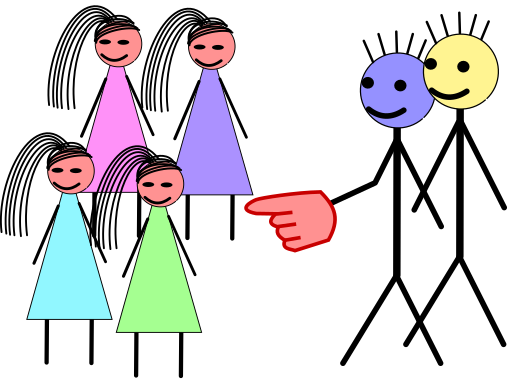Hello everyone, welcome to this Hungarian lesson, which is about:
The Hungarian personal pronouns
I’m sure that your grammar alert just went off, but trust me, personal pronouns are the basic construction bricks of a language. Personal pronouns are those things in a language that makes for us possible referring to persons without telling their names all the time. I mean these: I, you, he, she, it, we, you, they and me, you, him, her, it, us, you, them.

Unlike English, Hungarian is an agglutinative language which means that it expresses relations by stringing together different word endings or suffixes. The English language realizes this through changing the word order. This different approach makes it possible for Hungarians to construct sentences in any order they wish. Hungarian also uses a complex case system, the nouns can be declined with many case suffixes, most of which correspond to English prepositions. This is why we have so many personal pronouns, much more than in English.
In this Hungarian lesson we will start with the simple, most common Hungarian pronouns, and later we will move towards the more sophisticated ones. So, here comes the simple, nominative case (nominative is the person or thing doing the action) of the Hungarian pronouns:
The nominative case:
én – I
te – you
ő – he, she
mi – we
ti – you
ők -they
Examples:
Én budapesti vagyok. – I am from Budapest.
Te szereted a gulyást? – Do you like goulash?
Ő nem jön velünk. He/She doesn’t come with us.
Mi itthon maradunk. – We stay home.
Ti hazamentek? – Are you going home?
Ők nem szeretnek horgászni. – They don’t like fishing.
In Hungarian there is no distinction between genders, there is no masculine and feminine pronoun like the English he and she, we use the same pronoun ő for both genders. The personal pronoun that stands for I – én, is only capitalized when it stands at the beginning of a sentence.
Now is the time when things become more complicated.
The accusative case
The personal pronouns can form many cases, among which the nominative one was the simplest. The next case is the accusative case, which you can understand from this example:
I like him.
In this sentence, the personal pronoun “I” is in the nominative case, but “him” is in the accusative. An accusative pronoun is the object of the sentence, meaning that it is affected by the subject (the nominative pronoun). This sounds like this in Hungarian:
Én nem kedvelem őt. I don’t like him/her.
The personal pronoun “őt” is in the accusative case.

Let’s see all the other personal pronouns in accusative:
engem – me
téged -you
őt – him/her
minket / bennünket – us
titeket / benneteket – you
őket – them
You may have noticed that there are two forms for the accusative plural, both of which are in use, however, in modern day language Hungarian people prefer using the minket/titeket form. The bennünket/benneteket form sounds more old-fashioned and formal, and it has the plus meaning you all, no one is excepted.
e.g.
Ő szeret engem. He/she loves me.
Téged is meghívtak a buliba? Have you been invited to the party?
Őt nem láttam mostanában. I haven’t seen her/him lately.
Keresett minket valaki? Was anybody looking for us?
Titeket nem zavar ez? Are you not bothered by this?
Őket nem érdekli a politika. They are not interested in politics.
The dative case
The dative case’s main function is to show the indirect object of a verb. This means that it shows the noun to which something is given. If a personal pronoun stands in dative case, it indicates to whom that something is given.

e.g. Petra nekem adta ezt a táskát. Petra gave this bag to me.
Now let’s see how the dative case of personal pronouns looks like in Hungarian:
nekem – for me
neked – for you
neki – for her/her
nekünk – for us
nektek – for you
nekik – for them
e.g.
Nekem nem jó ez az időpont. This appointment isn’t good for me.
Neked jó ez? Is this good for you?
Neki hoztam az ebédet. I brought lunch for him/her.
Nekünk készült ez a torta? Was this cake made for us?
Nektek adom ezt a festményt. I give this painting for you.
Nekik szántam ezt a játékot, ajándékba. I meant this toy as a gift for them.
The instrumental case
The instrumental case of the personal pronouns is used in Hungarian to indicate the concept of “with”. It expresses “with whom” something is being done.
e.g. Veled megyek moziba. I am going to the movies with you.
 Here are all the Hungarian personal pronouns in the instrumental case:
Here are all the Hungarian personal pronouns in the instrumental case:
velem – with me
veled – with you
vele – with him/her
velünk – with us
veletek – with you
velük – with them
e.g.
Velem jössz? Are you coming with me?
Veled szeretnék a moziba menni. I would like to go to the cinema with you.
Vele tanulsz? Are you studying with him/her?
Velünk akarsz jönni? Do you want to come with us?
Veletek megyek haza. I am going home with you.
Velük készülök a versenyre. I am getting prepared for the competition with them.
The causative case
The causative case in Hungarian means “for whom” the action is performed, who is the one for the sake of whom something is being done.
e.g. Értem jött el. He came for me.
Here are all the Hungarian personal pronouns in the causative case:
értem – for me
érted – for you
érte – for him/her
értünk – for us
értetek – for you
értük – for them
e.g.
Ne gyere értem. Don’t come for me.
Érted mindent megtennék. I would do anything for you.
Érte kell mennem? Do I have to go for her/him (to pick her/him up)?
Siess értünk, légy szíves! Please, hurry for us (to pick us up)!
Értetek teszem ezt. I am doing this for you.
Értük, a családomért dolgozom. I am working for them, for my family.
You probably have noticed that what we call a case in Hungarian is usually expressed by a preposition in English. So, the entire case system may sound difficult and complicated, but it isn’t, we are just talking about prepositions and pronouns expressed together in a word.
In this Hungarian lesson, we have spoken about the nominative, accusative, dative, instrumental and causative cases of the Hungarian personal pronouns. There are many more cases: the inessive, superessive, adessive, illative, sublative, allative, elative, delative and ablative ones. If you want more, you can learn about all these cases here. Don’t worry if you find it overwhelming, just don’t try to learn them all at once. Remember: the names of all these cases are not that important, try to learn some examples, and you will do just fine.
Thank you for your interest in Hungarian grammar. If you made this far, you are a true grammar hero! 🙂
If you liked this post, please, hit the like button, and share it with your friends, so they could learn from it, too. Thank you!








